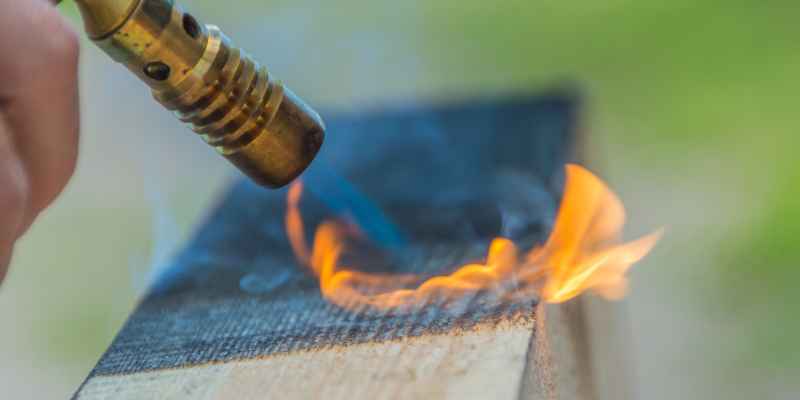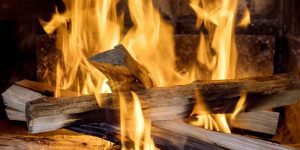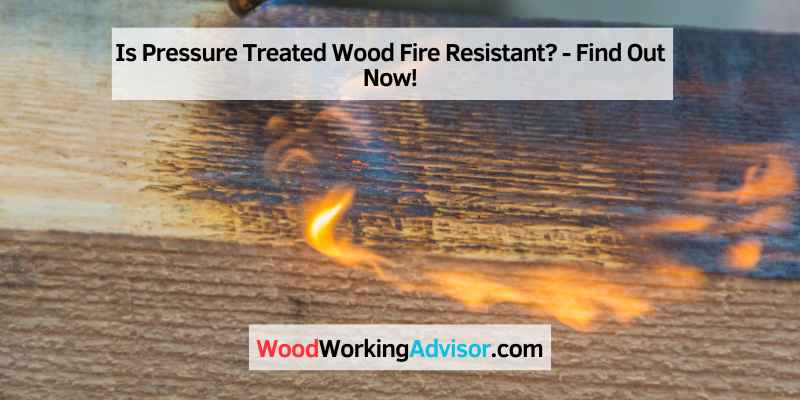Pressure treated wood is not inherently fire-resistant. Never burn pressure-treated wood as it releases harmful chemicals when burned.
What Is Pressure Treated Wood?
Pressure treated wood is not fire resistant. It is not recommended to burn treated wood indoors or outdoors because it releases chemicals in the smoke and ash. Fire-retardant wood goes through a different treatment process to withstand heat and reduce the spread of flames.
Definition And Process
Pressure treated wood is a type of lumber that undergoes a special treatment using chemicals that increase its resistance to environmental conditions that could easily cause decay or rot. This process involves using a pressurized system that infuses the wood with these chemical preservatives, which then penetrates deep into the wood fibers, providing excellent protection against insects, fungi growth, and general wear and tear. The chemical mixture used in the treatment process usually consists of a blend of copper-based components and is applied to the wood using a high-pressure cylinder.
Is Pressure Treated Wood Fire Resistant?
While pressure-treated wood is highly resistant to many environmental factors, it is not fireproof. Burning treated wood releases chemicals that can be harmful to the environment and anyone who inhales the smoke and ash. It is highly recommended that you never burn pressure-treated wood indoors or outdoors. However, pressure-treated wood can still be used for construction in areas prone to wildfires, as it is less susceptible to catching fire than untreated wood.
Can Wood Be Treated To Be Fire-resistant?
Yes, wood can be treated with fire-resistant chemicals to withstand heat and reduce the spread of flames. Fire-retardant wood starts as kiln-dried, untreated plywood, which is then treated with chemicals that resist flame spread and smoke. These chemicals are either applied to the surface of the wood or incorporated into the structure of the wood using a pressure treatment process. Fire-retardant wood is not fireproof, but it is less likely to catch fire and spread flames quickly.
In conclusion, pressure-treated wood is not fire-resistant, and it is not safe to burn it. However, treated wood can be fire-retardant, which means it’s less likely to catch fire and spread flames quickly. If you live in a wildfire-prone area or are worried about fire hazards, you should consider using fire-retardant wood for construction purposes.
Why Is Fire Resistance Important For Wood?
Pressure treated wood is not fire-resistant, and it’s critical to not burn treated wood because it releases harmful chemicals. Fire-retardant wood, on the other hand, undergoes a unique treatment process that helps it withstand heat and decrease flame spread.
Importance Of Fire Resistance In Wood
Fire resistance in wood is crucial because it could mean the difference between safety and disaster. Fire resistance means that wood is treated to withstand high temperatures and prevent the spread of flames. Fire-retardant wood goes through a special treatment process, which includes using fire-resistant chemicals that are infused into the wood. These chemicals work to slow down the spread of fire and avoid catastrophic damage.
Dangers Of Fire With Untreated Wood
Untreated wood is highly flammable, and when exposed to fire, it can quickly ignite and spread flames, posing a significant danger to people and property. Untreated wood can provide fuel to help the fire spread easily. For instance, in cases of wildfire, untreated wood can be extremely dangerous as it can cause a rapid spread of flames and, ultimately, lead to loss of life and property destruction. Using untreated wood in construction or outdoor activities can also be dangerous, and it is highly discouraged.
It’s important to remember that you should never burn treated wood indoors or outdoors as burning this type of wood releases chemicals in the ash and smoke, which can cause serious health problems. Hence, using fire-retardant wood could minimize the risk of fire disasters while ensuring the safety and well-being of people and valuable assets.
Can Pressure Treated Wood Be Fire Resistant?
Pressure-treated wood is not fire-resistant, and should never be burned indoors or outdoors. This type of wood releases chemicals in the ash and smoke when burned. In contrast, fire-retardant wood undergoes a special treatment process with chemicals that reduces the spread of flames and withstands heat.
Pressure-treated wood is a popular building material used for outdoor projects such as decks, fences, and playground equipment. However, there is a common misconception that pressure-treated wood is fire-resistant. So, can pressure-treated wood be fire-resistant? Let’s take a closer look.
Explanation of Common Misconceptions
Many people believe that pressure-treated wood is fire-resistant due to its natural ability to resist decay and insect damage. However, pressure-treated wood is not inherently fire-resistant and will burn when exposed to fire. In fact, burning pressure-treated wood can release toxic chemicals, making it dangerous to burn both indoors and outdoors.
Factors Affecting Fire Resistance
The fire resistance of pressure-treated wood depends on several factors, such as the type of wood, the chemical treatment used, and the thickness of the wood. The most commonly used fire-retardant chemicals for pressure-treated wood are ammonium phosphate and ammonium sulfate. These chemicals are infused into the wood using a pressurized system, making the wood more resistant to fire.
Benefits of Pressure Treated Fire Retardant Wood
Despite not being completely fire-resistant on its own, pressure-treated fire retardant wood has several benefits. These include:
1. Increased fire resistance – Pressure-treated fire retardant wood is more resistant to fire than untreated wood. This can help prevent the spread of fire in the event of a fire.
2. Increased durability – The chemical treatment used in pressure-treated fire retardant wood makes it more resistant to decay, insects, and moisture, increasing its lifespan and durability.
3. Code compliant – Many building codes require the use of fire-retardant wood in certain types of construction, such as multi-family dwellings and commercial buildings. Pressure-treated fire retardant wood meets these requirements.
In conclusion, while pressure-treated wood is not fire-resistant on its own, it can be treated with fire-retardant chemicals to increase its resistance to fire. However, it’s important to never burn pressure-treated wood, as doing so can release toxic chemicals. If you want to use pressure-treated wood for your outdoor projects, consider using pressure-treated fire retardant wood for added safety and durability.
Types Of Fire Retardant Wood
Pressure treated wood is not fire resistant but can be made fire-retardant through a special treatment process. Fire retardant wood is infused with chemicals under pressurized conditions to reduce its flammability and withstand heat. Burning treated wood indoors or outdoors is dangerous and releases harmful chemicals.
Fire safety is crucial in every environment, especially if you’re building a home or commercial space. When purchasing fire-resistant wood, you also need to know that not all types of wood are created equal. There are a few different types of wood used to make fire-retardant wood. Here are the three most common types:
Fire-retardant Plywood
Plywood is made up of layers of wood veneer. However, fire retardant plywood goes through a special treatment process. The manufacturer first kiln-dries, untreated plywood. Then, they use a pressurized system to inject the wood with fire-resistant chemicals. This process strengthens the wood and makes it more difficult for flames to spread.
Ipe Wood
Ipe (pronounced “ee-pay”) wood is known as “ironwood” for a reason. It’s an extremely dense and durable wood that’s naturally resistant to fire. Although it’s not completely fireproof, it’s a much safer option than other types of wood.
Comparison: Pressure Treated vs. Coated Fire Retardant Wood
Pressure-treated wood is a type of wood that’s been treated with chemicals to make it more resistant to decay, rot, and pests. However, it’s important to note that pressure-treated wood isn’t fire-resistant. Burning this type of wood releases chemicals in the ash and smoke, which can be harmful to humans.
Coated fire-retardant wood, on the other hand, is treated with a coating that’s applied to the wood surface. This coating reduces the spread of flames and smoke. While both pressure-treated and coated fire-retardant wood can resist some level of fire, coated fire-retardant wood is the safer option for fire safety.
In conclusion, when it comes to fire safety, it’s important to choose the right type of wood. Fire-retardant plywood and Ipe wood are both excellent options for fire-resistant wood. However, coated fire retardant wood is the best option for long-lasting fire resistance.
How Is Fire Retardant Wood Treated?

Fire-retardant wood goes through a special treatment process to withstand heat and reduce the spread of flames. Pressure-treated wood may resist some level of fire, but it is not fire-resistant. Manufacturers use a pressurized system to infuse fire-resistant chemicals into the wood, while fire-retardant wood starts as kiln-dried untreated plywood.
When it comes to building materials, one of the key concerns for many people is fire safety. That’s why fire-resistant wood has become increasingly popular in recent years. Fire-retardant wood undergoes a special treatment process to withstand heat and reduce the spread of flames. The process of infusing fire-resistant chemicals into the wood is what makes it resistant to fire. But how is this process done?
Pressure Treating Vs. Coating
There are two main methods for treating wood to make it fire-resistant. The first is pressure treating, which is the most common method. Pressure-treated wood is infused with fire-retardant chemicals under high pressure, which ensures that the chemicals penetrate deep into the wood fibers. This results in long-lasting protection against fire, as well as decay and insect damage.
The second method is coating the wood with a fire-retardant solution. This method involves applying a special fire-resistant coating to the surface of the wood. While coating can be effective, it doesn’t offer the same level of protection as pressure-treated wood. Also, coatings can wear off over time, which means they will need to be reapplied periodically.
Process of Infusing Fire-Resistant Chemicals
The process of infusing fire-resistant chemicals into wood starts with kiln-dried, untreated plywood. The wood is then loaded into a treatment chamber where it is placed under high pressure. The chamber is filled with a solution of fire-retardant chemicals, which are forced into the wood fibers by the pressure. This process ensures that every part of the wood is treated, including the interior of the wood fibers.
The type of fire-retardant chemicals used depends on the type of wood being treated and the level of fire resistance required. Some common chemicals used in the treatment process include ammonium phosphate, borates, and ammonium sulfate.
In conclusion, when it comes to fire safety, pressure-treated wood is the most effective option. It offers long-lasting protection against fire and can also protect against decay and insect damage. While coatings can provide some protection, they don’t offer the same level of fire resistance as pressure-treated wood.
Precautions To Take With Pressure Treated Wood
Pressure-treated wood is not fire-resistant, and burning it can release harmful chemicals. To stay safe around treated wood, avoid burning it both indoors and outdoors. Fire-retardant wood is a specially treated type of wood that can withstand high temperatures and flames.
Pressure treated wood is a commonly used material for outdoor structures, as it is designed to resist rot, insects, and decay. However, it is important to be aware of safety precautions when handling or using it. The chemicals used to treat the wood can be harmful to humans and pets if not handled properly. It is also important to note that pressure treated wood is not fireproof, and should not be burned.
Hazards of Burning Pressure Treated Wood
Burning pressure treated wood can be hazardous to your health. The chemicals used to treat the wood, such as chromated copper arsenate (CCA), can release toxins into the air. Inhaling these toxins can cause a variety of health problems, including respiratory issues, skin irritation, and even cancer. Additionally, burning this type of wood releases chemicals in the ash and smoke, which can contaminate the soil and groundwater.
Safety Measures while Handling Pressure Treated Wood
When handling pressure treated wood, it is important to take safety precautions to minimize exposure to the chemicals. Here are some safety tips to follow:
– Wear gloves and safety glasses to protect your skin and eyes.
– Wear a dust mask or respirator to protect your lungs from sawdust and fumes.
– Cut pressure treated wood outdoors to avoid inhaling sawdust.
– Do not burn pressure treated wood, as it can release hazardous chemicals.
– Wash your hands and tools thoroughly with soap and water after handling pressure treated wood.
In conclusion, pressure treated wood is a popular choice for outdoor structures due to its durability and resistance to decay. However, it is important to handle it with care and avoid burning it to prevent exposure to harmful chemicals. By following these safety measures, you can enjoy the benefits of pressure treated wood while minimizing any potential risks.
Applications Of Fire-resistant Wood
Pressure treated wood is not fire-resistant and should never be burned indoors or outdoors. Fire-retardant wood, on the other hand, is treated with special chemicals to withstand heat and reduce the spread of flames. Kiln-dried and untreated plywood is first infused with these chemicals using a pressurized system.
When it comes to building with wood, fire safety is always a concern, especially in areas prone to wildfires or with strict building codes. That’s why fire-resistant wood has become an increasingly popular option for siding, decking, and fencing. This type of wood has gone through a special treatment process that allows it to withstand heat and reduce the spread of flames. In this blog post, we’ll take a closer look at the different applications of fire-resistant wood, including siding, decking, and fencing, as well as new construction and rebuilding after fire damage.
Siding
Fire-resistant wood siding is an excellent choice for homes in wildfire-prone areas. Most fire-resistant wood siding products are made from treated wood, where the wood has been impregnated with fire-retardant chemicals, which can help slow down the spread of fire. When it comes to fire-resistant siding, composite and fiber cement siding are also popular options. Composite siding is made from a mixture of wood fibers and synthetic materials, while fiber cement siding is made from cement, sand, and cellulose fibers. Both options offer excellent fire resistance, durability, and low maintenance.
Decking
Wood decking adds value and beauty to any home, but traditional wood decking can be a fire hazard. That’s why pressure-treated fire-resistant wood decking has become a popular choice. Pressure-treated wood undergoes a special treatment process that forces fire-retardant chemicals deep into the wood fibers, providing long-lasting protection against decay, insects, and, of course, fire. Composite decking is also a great alternative to traditional wood decking as it is made from a mixture of wood fibers and plastic, which makes it fire-resistant, low maintenance, and highly durable.
Fencing
Wood fences are a popular addition to many homes, but they too can pose a fire hazard, particularly in areas where wildfires are prevalent. Pressure-treated fire-resistant wood fencing is a great choice for homeowners looking for a high level of protection. There are also other types of fire-resistant fencing available, including metal and vinyl fences, which offer excellent fire resistance and durability.
New Construction And Rebuilding After Fire Damage
If you are rebuilding after a fire or building a new home in a wildfire-prone area, fire-resistant wood is an excellent choice. Fire-retardant wood starts out as kiln-dried, untreated plywood, and then the manufacturer uses a pressurized system to infuse the wood with fire-resistant chemicals, which helps to slow down the spread of flames. Because of its superior fire resistance, fire-resistant wood has become mandatory in some areas, particularly in areas with a high risk of wildfires.
In conclusion, fire-resistant wood is an excellent choice for homeowners looking for added protection against wildfires or building code requirements. With the variety of fire-resistant wood available, including siding, decking, and fencing, you can easily find a solution that works for your specific needs. When building a new home or rebuilding after fire damage, be sure to consider fire-resistant wood as an option for added peace of mind.

Frequently Asked Questions On Is Pressure Treated Wood Fire Resistant
Can You Have A Fire With Pressure-treated Wood?
No, you should never burn pressure-treated wood, as doing so releases chemicals in the ash and smoke. However, fire-retardant wood can be treated with chemicals and has undergone a special treatment process to reduce the spread of flames and withstand heat.
It’s important to stay safe around treated wood and avoid burning it indoors or outdoors.
Can Wood Be Treated To Be Fire-resistant?
Yes, wood can be treated to be fire-resistant. Fire-retardant wood undergoes a special treatment process where it is infused with fire-resistant chemicals through a pressurized system. This treatment process helps the wood withstand heat and reduces the spread of flames.
However, it is important to note that burning treated wood releases chemicals in the ash and smoke, making it unsafe to burn both indoors and outdoors.
What Wood Is Fire Proof?
Fire-retardant wood goes through a special treatment process to withstand heat and reduce the spread of flames. Ipe wood is considered as the king of fire-resistant wood. It is not recommended to burn any treated wood as it releases harmful chemicals.
Can Lumber Can Be Treated To Resist Flame Spread And Smoke?
Yes, lumber can be treated to resist flame spread and smoke. Fire retardant chemicals can be applied to the surface or incorporated into the structure of the wood to make it more fire-resistant. It is important not to burn treated wood, as it releases chemicals in the smoke and ash.
Conclusion
To conclude, pressure-treated wood is not fire resistant. In fact, burning this type of wood can release some dangerous chemicals into the environment. However, fire-retardant wood can ensure your safety as it undergoes a special treatment process to withstand heat and reduce the spread of flames.
It is important to understand the difference between fire-resistant and fire-retardant wood to take appropriate measures for your safety. So, make sure to use safe wood options while enjoying your indoor or outdoor fire activities.


